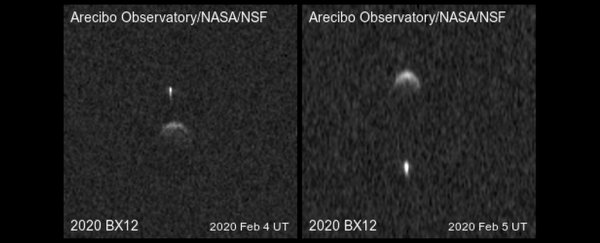A large asteroid whooshed past Earth last week, and mooned all of humanity in the process.
As it approached Earth space, asteroid 2020 BX12 was under close observation. Clocking in at 200 to 450 metres across (656 to 1,476 feet), and moving at around 90,000 kilometres per hour (56,000 miles per hour), the space rock was one of the larger ones to enter our vicinity in recent weeks.
It passed safely by at a distance of over 4.3 million kilometres (2.7 million miles) on February 3, placing it at over 11 times the distance of the Moon, so you can chill about the prospect of total devastation.
As it passed, and continued to move away, astronomers at Arecibo Observatory's Planetary Radar Science Group in Puerto Rico took 2020 BX12's photo. And they noticed it wasn't alone.
The asteroid has its very own moon - a tiny little thing just 70 metres (230 feet) across.
"Preliminary analysis suggests that the primary asteroid is a round object at least 165 metres in diameter rotating approximately once every 2.8 hours or less," they wrote in an announcement.
"The satellite has a diameter of approximately 70 metres and rotates once every 49 hours or less. The distance between the two bodies is at least 360 metres, as observed on February 5.
The movement of the satellite between the two observations, which were made ~23 hours apart, suggests a mutual orbital period of 45-50 hours and would be consistent with a tidally locked satellite."
It's actually not that strange for asteroids to have moons of their own. There's a bunch of asteroids in the main asteroid belt that are known to have their own moons, and around 60 near-Earth asteroids of the roughly 16,400 known have at least one moon.
But because asteroids are so hard to spot, data on how many of them have moons is incomplete. Some asteroids even have two moons, and very rarely you get a binary asteroid where both are around the same size.
We don't know how asteroids get moons, either. They could form together, like binary stars; they could be chunks that are from the same collision; or they could snare each other as they pass by.
The more moony asteroids we find, the better we can try to understand them.
2020 BX12 is a member of the Apollo group of near-Earth asteroids that swing between inside Earth's orbit, and out past Mars. It's due to pass Mars in June of this year, and while it will swoop past Earth in 2022 and 2024, it will be at a much greater distance than this year's flyby.
In fact, 2020 BX12 won't come as close to Earth at least within the next 90 years.
Bye, asteroid buddy! Thanks for showing us your moon!
